A dog’s life at Base Ohakea

OCT | 23
#262
P-8A exercising with Indian Navy
NH90s in major conservation effort
New Air Force leaders take the rein
OUR MISSION
The RNZAF will provide New Zealand with relevant, responsive and effective Air Power to meet its security interests.
OUR VISION
An agile and adaptive Air Force with the versatility essential for NZDF operations.

COVER: A dog’s life at Ohakea

PHOTOGRAPHER: CPL Maddy Butcher
Published by Defence Public Affairs HQ NZ Defence Force Wellington, New Zealand
Editor Rebecca Quilliam
Email: airforcenews@nzdf.mil.nz
Design and Layout Defence Public Affairs
Printed by Bluestar Private Bag 39996, Wellington
Distribution Email: airforcenews@nzdf.mil.nz


Editorial contributions and ideas are welcomed. They can be emailed directly to the Editor and do not need to be forwarded through normal command chains.
Contributions need to include • writer’s name, rank and unit • photos provided separate from the text – at least 300dpi.
Air Force News will hold the copyright for submitted articles or photographs it publishes. Articles and photographs published in Air Force News cannot be published elsewhere without permission.
ISSN 1175–2337 airforce.mil.nz
Contents
News 18 By techs for techs 19 NZDF cyber capability tested in US military exercise 20 Skilful WorldSkills 26 Healthy heads
03 First
Heritage 28 Sport 33 Notices
Regulars
Word 22 Our
34 Photo of the Month
04 NH90 in major conservation effort 06 Namaste Indian Navy 08 First step for C-130J transition 09 C-130J Hercules simulator takes off 10 A dog’s life at Base Ohakea 16 New Air Force leaders take the rein 2 | AIR FORCE NEWS #262
First Word
And as we consider the future, perhaps to a greater degree than we have seen for decades, there are a number of complex and interconnected security challenges on the virtual horizon, approaching at high speed. Those familiar with recent policy announcements will recognise the concepts of strategic competition, security related aspects of climate change, and the increasing global spend on defence, acting to accelerate and intensify those primary drivers. As the Chief of Defence Force has recently described, problems aren’t queuing up waiting to be dealt with one by one.
In response to these challenges we must stay focussed on our core purpose. The Air Force must be able to conduct military air operations as part of an integrated, networked force, doing so in a joint and combined environment – or in more stark and simple terms, we must be able to fight and to win.
But as I started with, air power is mostly about you, the aviator. To realise that human potential there are two things I ask of you; know exactly what your job is, and then attempt to do that job to the very best of your ability.
Finally, let me thank you for your continued dedication and commitment to serve. I’m excited to be surrounded by motivated and capable people ready to tackle whatever challenges come our way. That’s what we’re all about, always will be.
It’s a privilege to be given the chance to write this First Word as your new Chief of Air Force. My journey started early, born into an Air Force family my first memories are of the toetoe bushes and bomb dump huts behind our quintessential weatherboard Married Quarter in the Keyhole at Base Ohakea. While much has changed over the years, including more grey hairs, many critical aspects remain the same – generating military air effects continues to be a people-centric endeavour by trusted and motivated men and women.
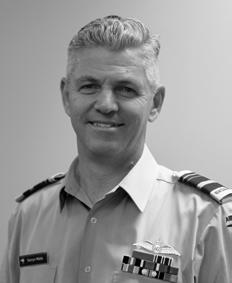
There are a number of things that we will rely on to achieve that outcome. Recruiting, training and retaining our talent is essential. Further developing our warfighting ethos and culture where readiness is closely linked to our required combat effectiveness. Partnerships and interoperability will be increasingly important, especially with Australia as our neighbour and ally. And as a small force it’s also vital we make the most of that agility by empowering our capable, trusted leaders and operational decision makers.
I hope you’re picking up on my sense of urgency and desire to build momentum on our core purpose, to maximise the utility of those newly acquired capabilities and demonstrate the value and criticality of our Air Force.
FIRST WORD |
B Y
CHIEF OF AIR FORCE AIR VICE-MARSHAL DARRYN WEBB
“At the heart of success, it is your innovation and curiosity that are essential ingredients to maximise the effectiveness of a compact but professional team, and change will be a constant feature of our present and future as we rapidly adapt to opportunities and threats alike.”
AIR FORCE NEWS #262 | 3
NH90 in major conservation effort

No. 3 Squadron delivered 560 traps weighing 4,400kg into the Ruahine ranges to support New Zealand Department of Conservation (DoC) Te Papa Atawhai pest control operations.
It was the largest delivery of traps into the hills anywhere in Aotearoa New Zealand in one day and will make a significant contribution to the protection of both eastern brown kiwi, whio (blue ducks), robins, snails and rare plants in the region.
Tropical Cyclone Gabrielle significantly impacted the population of whio by sweeping away current traps and introducing large amounts of gravel into the rivers reducing their food supply, DoC Principal Advisor Terrestrial Biodiversity Paul Jansen said.
“Ecologically it is a very significant site that was impacted heavily by the cyclone. We can’t control weather, so we look to mitigate the effects of that event. We increase the management we normally apply and get traps out there to replace the ones that have been washed away, extending the network so we have better resilience for those populations.”
The NH90 delivery was the single biggest lift of traps into the back country that the department has ever done in one day, by about three times, Mr Jansen said. The traps will capture mostly stoats, weasels and some rats. Possum numbers are being kept in control by 1080 drops.
| OPERATIONS
SQUADRON LEADER KIRI OHLSON & REBECCA QUILLIAM B Y
4 | AIR FORCE NEWS #262
“Because of the NH90 delivery, that trap network will now cover about 40,000 hectares of the Ruahines, with the total area being about 76,000 hectares,” Mr Jansen said.
Whio number less than 3000 throughout Aotearoa with about 1000 North Island sub-species. About 100 breeding birds are homed at the Ruahine ranges.
Sergeant (SGT) Evan McKenzie was one of the helicopter loadmasters for the flight. “It was heavy work. The bags weighed up to 125kg each and we used the hoist to get them into the aircraft, but there still needed to be a bit of manhandling from the crew to get them in and out of the helicopter – I worked up a bit of a sweat.
“We were taking five bags per trip 39 bags in total. The beneficial thing about the NH90 is that we can carry a lot more than smaller civilian aircraft –we do the heavy lifting and then the civvy guys come in and fly them to the more remote areas.


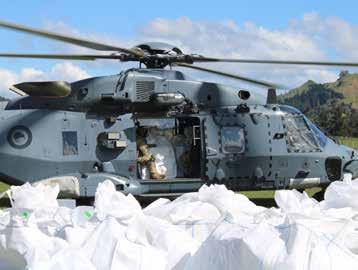

“It was pretty cool to be a part of and the DoC guys loved having us there. It was lots of work done in a short amount of time,” SGT McKenzie said
Now that the traps are in position DoC uses smaller civilian helicopters to disperse smaller bundles of traps to more remote areas and various groups such as Mauri Oho, the Whio Protectors, Ruahine Kiwi and DoC volunteers will place them in location by foot throughout the ranges.
OPERATION S |
“The biggest issue with these traps is their sheer weight and bulk. So the ability to lift those up in large amounts with a large helicopter certainly streamlined the operation.”
– Paul Jansen, Department of Conservation
AIR FORCE NEWS #262 | 5
Namaste Indian Navy
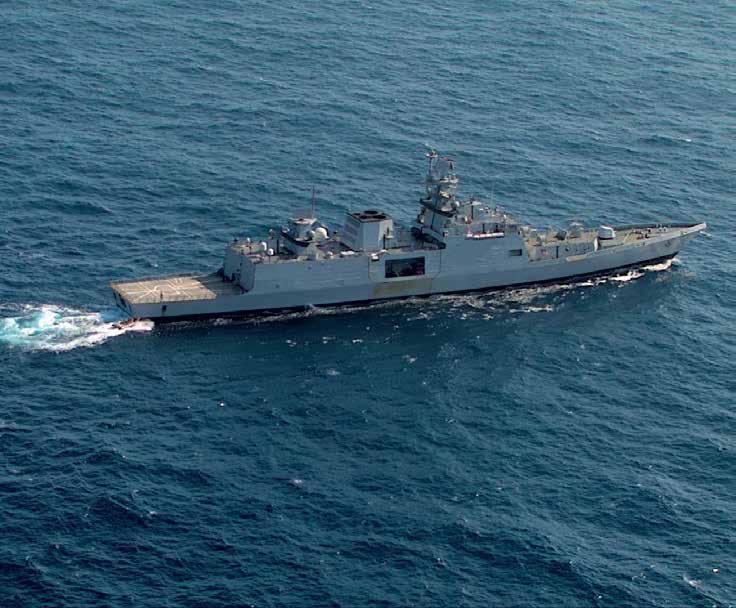 EDITOR REBECCA QUILLIAM B Y
EDITOR REBECCA QUILLIAM B Y
The aircraft was returning from the Royal Australian Air Force’s Base Edinburgh near Adelaide, where crews had been undertaking warfare training in their simulator and in the aircraft.
The crew had been there for two weeks and also had the opportunity to work alongside the Royal New Zealand Navy frigate HMNZS Te Mana, which was sailing along Australia’s east coast.
“We were training in anti-submarine warfare procedures and anti-surface warfare procedures,” weapons and tactics officer Flight Lieutenant (FLTLT) Reece Tamariki said.
“We’re releasing capability for the P-8A slowly. We started with search and rescue, then fishery patrols and now we’re getting into the warfare training. With the anti-submarine warfare, we’re leaning on a lot of P-3K2 experience and how we might search for a submarine and applying it to the P-8A.
“The same goes for the anti-surface warfare training – so there was a simulated enemy warship threat out there and we would again look to our P-3K2 experience to develop a procedure to search for that enemy and see if it works with the P-8A.”
The aircrew dropped Acoustic Training Targets that behave in the same manner as submarines, which the air warfare officers then have to track.
|
EXERCISES
6 | AIR FORCE NEWS #262
Aircrew on one of our P-8A Poseidons was able to call in on a couple of Indian Navy ships as the vessels were leaving Aotearoa New Zealand recently.
On the crew’s return home, they were able to participate in training with the Indian Navy’s guided missile destroyer INS Kolkata and multi-role frigate INS Sahyadri, which had been on a four-day supply visit to Aotearoa.
“On their way home we were passing each other, so we stopped in to say hi,” FLTLT Tamariki said.
“We flew about half a dozen low passes over the ships for a photography exercise. We raised communications with them. They then sent a couple of RHIBs (rigid-hulled inflatable boats) out a couple of miles ahead of the ships and the crews had cameras on board and could get photos of us.
“We were talking with the bridge asking them what altitudes they wanted to see, so it was great to be able to help with their training. We probably spent about an hour doing that.”
The commander of the INS Sahyadri came on the radio and thanked the P-8A’s crew for their help.

“He had a pretty decent speech about the cooperation between the Indian Navy and the New Zealand Defence Force and how we were stronger together. We wished them gentle seas and calm winds for their journey home.”
During many exercises communication between different services could be challenging, FLTLT Tamariki said.
“But we brought them up on the radio and it was smooth sailing for our interaction. Our photos got to them quickly and theirs came through to us quickly too. They were awesome shots from the Indians.” It was the first time in about 17 years FLTLT Tamariki had seen an Indian warship, so it was great to be able to have the rare opportunity to work with them, he said.
“I was surprised and stoked that they sent a couple of big warships out to us in the South Pacific.”
EXERCISE S |
AIR FORCE NEWS #262 | 7
Crucial step towards journey to the C-130J

For the past 60 years the C-130H model has delivered tactical air mobility support around the globe… to the four winds.
The C-130J Transition Unit (JTU), headed by Wing Commander (WGCDR) Gareth “Case” Russell, will focus on ensuring the smooth introduction of the new C-130J Hercules, and said this much anticipated milestone was incredibly exciting.
“The C-130J is the next step in modernising our fleet and increasing our capability; it can fly further, faster and carry more passengers and cargo than we’ve been able to achieve before.
“Standing up a transition unit is essentially building a unit from the ground up. As military professionals we are practiced in regularly changing roles. Normally this involves moving into a position where the team around you knows their job inherently. In the case of a transition ‘pop-up’ unit, building foundational relationships, structures and culture is a unique challenge.”
WGCDR Russell is looking forward to the coming weeks and months when more personnel will come on-board to fill JTU’s critical functional needs.
“There is flexibility to evolve the JTU as we need, to deliver our mission. The end state is that we will be absorbed into
No. 40 Squadron, which incorporates Boeing flight and Hercules flight as an integrated team,” WGCDR Russell said. Speaking of integrated teams, WGCDR Russell wanted to recognise the years of work that have been done to get the Future Air Mobility Capability (FAMC) project to this point.
“The Integrated Project Team (IPT), past and present, has been outstanding in preparing the way for the delivery of trained personnel, aircraft and supporting systems for JTU to employ on the path to operational release.”
WGCDR Russell said the introduction of any new capability requires significant work, not least by the New Zealand personnel based overseas.
“We currently have maintenance, aircrew and support personnel training and working across several locations in the United States of America. The dedication of these aviators and their families is critical to mission success at the speed of relevance.
“The skill and professionalism of this team will ensure that the C-130J contribution to No. 40 Squadron continues to serve Aotearoa New Zealand, as it has done since 1964.”
| FUTURE FORCE
EDITOR
B
REBECCA QUILLIAM
Y
The evolution of the RNZAF’s air fleet continues with the refresh of the fixed wing air mobility work horse, the C-130 Hercules based at RNZAF Base Auckland.
*Please note the version of this article in the print copy of Air Force News differs to this version 8 | AIR FORCE NEWS #262
C-130J Hercules simulator takes off
The life-sized replica cockpit has been built in Montreal, and will soon be transported by road to Tampa, United States, for the installation of equipment, software and visuals.
The full mission flight simulator is being assembled as part of the New Zealand Government’s $1.521 billion deal with the United States Government, to supply a fleet of five new Lockheed Martin C-130J Hercules, along with spare parts, crew training, publications, and a simulator.
Ministry of Defence Integrated Project Team Leader Andrew Rooney says the simulator is scheduled to touchdown in Aotearoa New Zealand in 2025.
“The simulator will be homed at Base Auckland, where No. 40 Squadron, which maintain and fly the Hercs, are based.
“Members of the project team and I recently visited the factory in Montreal and saw the simulator’s cabin under construction. It’s a very large cabin that fits seven crew inside. The cutting-edge technologies being installed will include a laser projector and glass bowl visual
system, which displays a realistic out-thewindow view for pilots. Full cockpit motion will also be replicated with a totally electric motion system.”
At Base Auckland, construction of the building to house the flight simulator is underway, with the piles and concrete base work nearly complete.
In order to accommodate the simulator, the building will be 40 metres high. Its 26 piles have been drilled 23 metres into the ground to support the weight of the simulator.
The next major construction milestone is the installation of the tilt slab walls. A new power distribution network will also be installed, to provide the building with sufficient power to operate it.
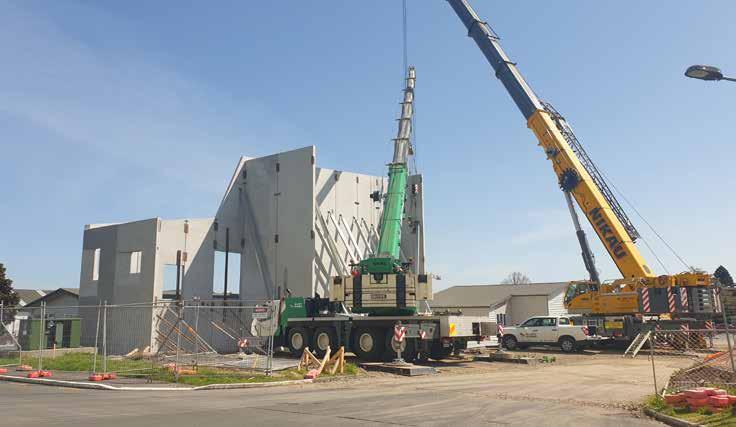
“Simulators reduce maintenance and flight time on actual aircraft, saving money and time, and reducing the risk to aircraft and people. Their use also improves crew preparedness and safety, who will be able to train for emergency situations and poor weather conditions while in a flight,” Mr Rooney said.
Another significant milestone recently completed was the training of No. 40 Squadron’s Crew One, who are now certified to fly a US Air Force C-130J aircraft.
“The crew recently received their flight certifications from the Rhode Island Air National Guard, so they can now fly Hercules with the United States Air Force at the Little Rock Air Force Base in Arkansas. This is a huge milestone for a New Zealand crew, and it follows a big effort from the Defence Force and the team at the Ministry of Defence,” said Wing Commander Steve Hunt.
Meanwhile the construction of the fleet is well underway, with all five aircraft on the production line. The first aircraft is now fully built with its engines and systems installed, and testing is underway. New Zealanders can expect to see the first C-130J Hercules aircraft touchdown next year.
FUTURE FORCE |
The first phase of construction of New Zealand’s high tech C-130J Hercules flight simulator has been completed in Canada.
AIR FORCE NEWS #262 | 9
SENIOR STRATEGIC COMMS ADVISOR RENEE LAUTUSI B Y

| FEATURE 10 | AIR FORCE NEWS #262 10
WORDS | SQUADRON LEADER KIRI OHLSON & REBECCA QUILLIAM PHOTOS | CORPORAL NAOMI JAMES & CORPORAL MADDY BUTCHER
A dog’s life at Base Ohakea
A new military working dog facility was recently opened by the Chief of Air Force in Base Ohakea. The facility has the capacity to hold up to 12 military working dogs. The military working dogs will perform security duties at the base to ensure the airfield and aviation assets are secure. This includes security patrols of Air Force assets both domestically and deployed overseas.
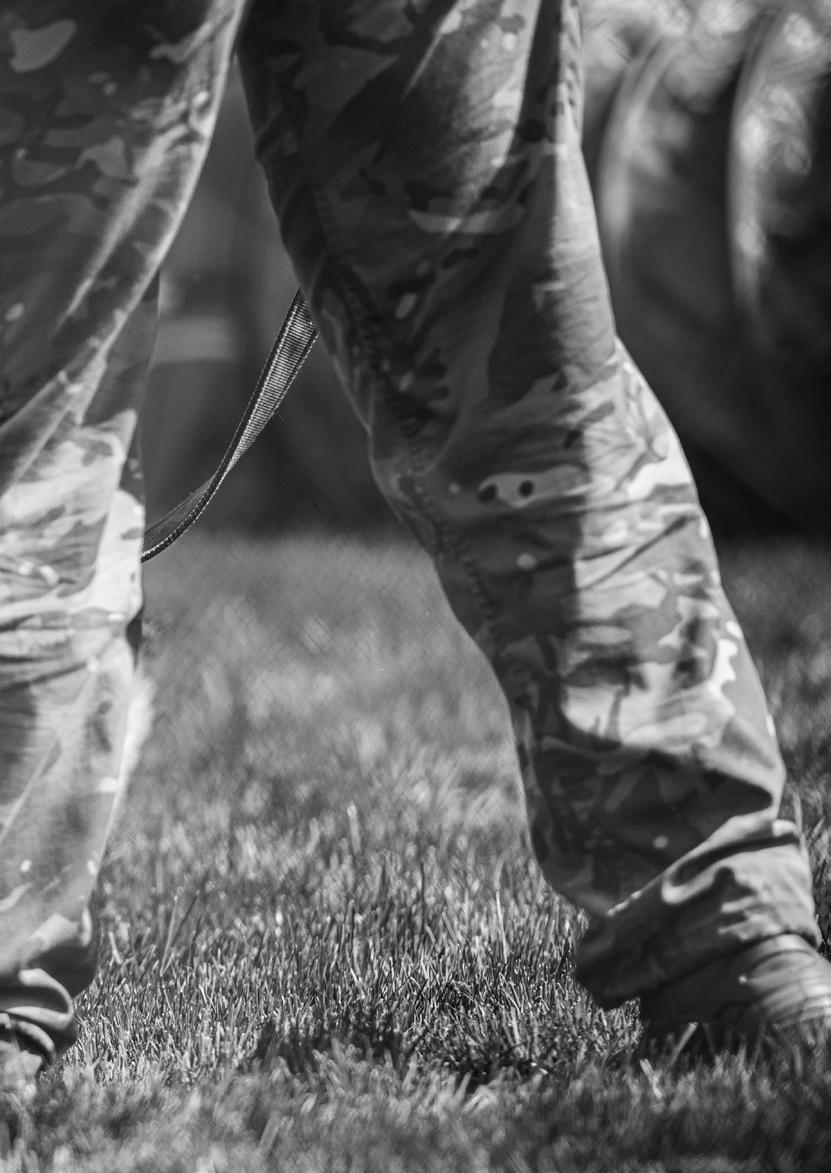
FEATURE | AIR FORCE NEWS #262 | 11
The working canines are now housed in a purpose-built facility with 12 kennels, enough to accommodate the working dogs and an isolation block, near the Biggin Hill Hangar.
It features large equipment storage areas, exercise yards and CCTV along the kennel lines to monitor canine activity. There will also be office space for the dogs’ handlers, plus senior supervisors.
The structure also features a hydrotherapy pool for the dogs, which is a conditioning and a habilitation facility for them to swim in that will be easy on their joints.

Squadron Leader (SQNLDR) Chris Hart, Commanding Officer Operations Squadron, said the new facility was important for the work the dogs do, performing security duties to ensure the airfield and aviation assets are secure. This includes security patrols of RNZAF assets both domestically and when deployed overseas.
“This would see the dogs employed with their unique capabilities to their full effect. They will see, hear and smell you before you see them, and then of course dogs are known for their teeth; our patrol dogs are trained to chase and bite to enable detaining intruders.”
Discussions about establishing a military working dog unit at Ohakea first began in 2021. When plans to move No. 5 Squadron from Whenuapai to Ohakea to operate the new P-8A Poseidon aircraft became official, work began to establish the unit and a purpose-built facility for dogs and their handlers.
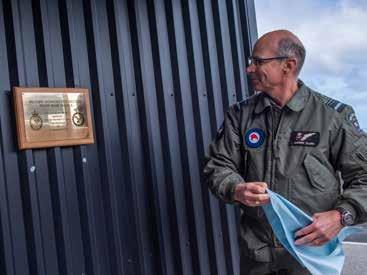
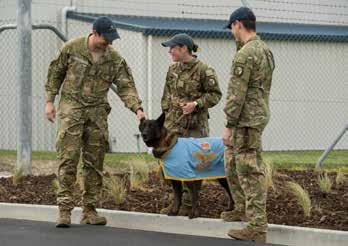
Aircraftman (AC) Ella Sands-Fore and her dog Havoc are recent graduates of the Military Working Dog basic course.
“The exercise yards are probably my favourite part of the new facility,” she said.
“It’s really good first thing in the morning letting them out so they can have a little play and do their thing. The pool is amazing, I can’t wait to try it out with my
| FEATURE
The work to re-establish military working dogs at Base Ohakea began in earnest once the P-8A Poseidon aircraft and No. 5 Squadron were expected to move down from Auckland.
1 2 3 ONE
TWO Dog handlers and a MWD at the facility’s opening THREE Entrance to the dog facility FOUR Kennels where the MWDs are housed FIVE Kennels where the MWDs are housed SIX MWD exercise area FEATURE 12 | AIR FORCE NEWS #262
Air Vice-Marshal Andrew Clark unveiling a plaque at the dog facility
dog. It’s nice to have somewhere that’s purpose built,” she said.
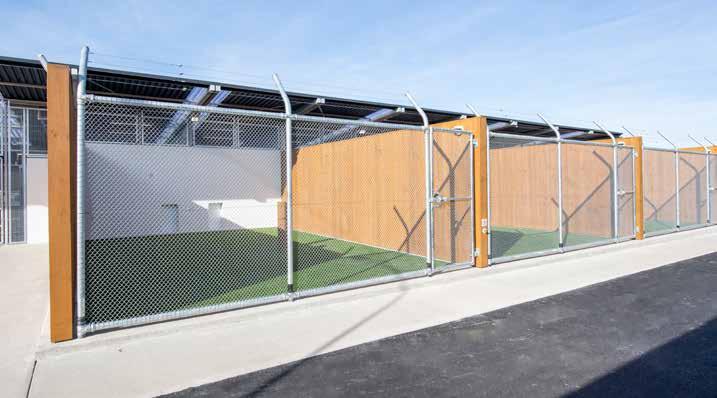
SQNLDR Hart said personnel training to become a dog handler begin their career in the Security Forces trade, before going through a selection process to become a dog handler and be paired with a dog.
“Every dog team is different but generally it takes 8-to-12 weeks to reach the required standard, depending on the experience levels of the handler and the nuances of each individual dog’s temperament and speed of learning.
“The sight, sense and smell of a military working dog is the equivalent to that of
seven people, but cannot be used in all locations because of the environment of quarantine implications. The Security Forces training pathway means you can either be employed with the military working dogs, or without. This gives our handlers greater utility in an operational setting.”
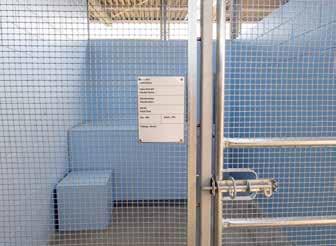
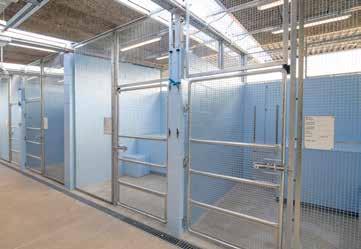
Handlers ensure dogs are fit for service through walks and runs, operational training and security patrols, grooming and daily health checks.
AC Sands-Fore said her dog Havoc is a Belgian Malinois, and has all the typical traits of that breed.
“He needs his exercise but if you have a toy or a treat he’ll do anything for you. He loves his bite work, anything to do with biting or tugging he loves that and playing with his toys.
“I love dogs, so this is pretty much my dream job because I get to hang out with them all day.”
FEATURE |
4 5 6 AIR FORCE NEWS #262 | 13
Strength through swimming
The first exercise and rehabilitation pool for Air Force Military Working Dogs is now in use at the new Security Forces MWD Section at Base Ohakea.

|
14 | AIR FORCE NEWS #262
FEATURE
Since the official opening of the building, the Security Forces Military Working Dog (MWD) handlers have started to see the benefits of what the hydrotherapy pool has to offer the dogs.

“We use the pool for both rehab and prehab,” Military Working Dog handler Leading Aircraftman (LAC) Charlotte Stevens said.
Prehabilitation is the term the unit uses to describe strengthening exercises for the dogs to prevent injuries.
The pool, with an area of about 2m by 3m, is heated and shallow enough for handlers to help the MWDs easily, but still with enough depth for the dogs to swim comfortably, LAC Stevens said.
“The rehabilitation pool is a completely new environment for the MWDs, with the smell of chlorine, a number of slippery surfaces and the hum of the system functioning. It provides mental stimulation for them as well and something that is different to their normal working routine.
“The pool itself has a current with different settings and the water provides the resistance so the dogs can improve their muscle strength without the use of their own weight. The swimming also reduces stress on their joints compared to other exercising they do.”
The dogs themselves have had mixed reactions to the pool, with some not having had an opportunity to experience that type of training before, LAC Stevens said.
“Some of them are apprehensive at first – especially if it’s new to them – so it will take them a few sessions to get used to it and familiarise themselves with it. But getting used to new things is always a benefit for the MWDs.
“For the first few sessions handlers need to be in the water with their dogs, because they will be unsure of the new environment.”
Once they have become accustomed to the training, they tend to enjoy it, she said. With the opening of the Military Working Dogs’ facility the handlers are going through a familiarisation period with their dog in the pool, to get them used to being near the pool, let alone inside it, LAC Stevens said.
“From there we’ll work on prehab plans for the dogs that might be two to three times a week. And if any dogs become injured we’ll implement a rehabilitation plan from the vet.
“We do have a dog from Auckland now, MWD Keno, who is going through a rehabilitation plan. That includes long walks and swimming every day. It’s been a bit of a mission because Keno’s shoulder is injured and we have to be very careful with him and the slippery surfaces created by rehabilitation pool water going everywhere.
“The rehabilitation pool is key to his recovery and may be the difference between Keno continuing as a MWD or being retired. Keno was unsure of the pool at first but he’s definitely coming around to the idea and we are already seeing improvements in him.”
The pool is different and new to all the handlers, but the opportunity to use the facility has been welcomed by them, she said.
“Although the rehabilitation pool is located at Base Ohakea it is a great step forward for continued support for our Defence Force MWD no matter where they are in their life cycle.”
FEATURE | AIR FORCE NEWS #262 | 15
Changes ahead for new ACC
The move comes off the back of studying for a year in London at Staff College, which is tucked in behind the King’s Buckingham Palace garden.
“Because it was so central it was easy for people to speak at the course – it’s not too far out of their way. So the people we had access to, was incredible for starters,” Air Commodore (AIRCDRE) Scott said.
During the year major international events took place including a war in Europe, the passing of Queen Elizabeth II and Coronation of King Charles III, and three changes of Government.
the job just as the Air Force is undergoing significant change.
“We weren’t talking about these things in theory because we could see in real time how, if these things are handled inappropriately, they could cause significant implications at a national and international level.
“How to use military was just one factor in what nations needed to be worrying about, so it was really preparing us to be in leadership positions within countries, as opposed to just looking after the military,” he said.
Looking ahead to his new position, AIRCDRE Scott said it was an exciting time for the Air Force with the arrival of the P-8A Poseidon and its roll-out into service, as well as looking at the arrival of the C-130J Hercules models.

“If we look at where we are going to be in three years, it’s looking like quite a different Air Force. We are looking at what is getting introduced and also at replacement options for the Seasprites and Boeing 757s – there are some huge changes and challenges ahead and making sure all the way through we’re still delivering on operations is really exciting.” AIRCDRE Scott is also focussed on personnel and opportunities that are available across the Air Force that have opened up over the past year.
“For people who are adequately trained and can demonstrate their performance, they are going to start very quickly moving through the organisation and I think that’s really exciting. I look forward to being able to empower our people as they come through and see what we can do to ensure they are getting the working environment that they want to work in.” Taking over the role from AIRCDRE Shaun Sexton meant filling some big shoes, AIRCDRE Scott said.
“I’d like to acknowledge that he’s done an incredible job with the changes and things that he has managed over his time as ACC (Air Component Commander). To see how far the air component has progressed under his watch is really impressive.”
| LEADERSHIP
B Y
EDITOR REBECCA QUILLIAM
Air Commodore Andy Scott has taken up the role of the Air Force’s Air Component Commander and has been posted to
16 | AIR FORCE NEWS #262
Eyes to the future “I
was leading planning for the investments or projects we’re going to start in the few years.
I was working closely with the Ministry of Defence to give that forward look as to what investments we might be asking Government for and how that stacks up against priorities for the Service and Portfolios.”
He pointed to three areas to focus on during his time in the Deputy Chief of Air Force role.
The first was about representing the Chief of Air Force and the Air Force within Defence Force Headquarters, with other Air Forces, on the Air Force Museum of New Zealand board, and ensuring aligned messaging from an Air Force point of view.

“The second piece is about the Air Force of today – what I think of as the mechanics of running an Air Force. You’ve got training, you’ve got finance, and you’ve got people, all those things we’ve got to manage day-to-day to keep the Air Force ticking over,” AIRCDRE Hunt said.
The third area was focussed squarely on the future and beyond the next five years.
“We need to start aligning ourselves into what our Air Force will look like in 20 years, what it needs to be delivering, what the Government expects, what our partners expect from us and making sure we can deliver.
“And that’s exciting because the developments in technology – cyber, artificial intelligence, the information domain, the space domain – those are all relatively new for us and their use will become more prevalent in the future. We need to have an idea of how we are going to approach sequence them into Air Force operations.”
AIRCDRE Hunt said today’s Air Force was wildly different to when he was recruited – with archaic mobile phones, no internet, and information not as readily available as today.
“Now there are so many avenues that are going to open up for new aviators as the Air Force moves quickly in line with the digital information age. The new capabilities like the P-8A Poseidon and C-130J Hercules will see changes in the way we operate, but the emerging technologies will bring some real game changers and people shouldn’t constrain their thinking about how we use it.
“There are opportunities for aviators to adjust and develop their careers to suit and I think we are much more open to this than perhaps we were 20, 30 or 40 years ago. It’s exciting times.”
EXERCISES |
B
EDITOR REBECCA QUILLIAM
Y
Air Commodore D.J. Hunt is soon to take up the reins of Deputy Chief of Air Force and he says his latest role in Capability Branch has prepared him to look to the future facing the Air Force.
AIR FORCE NEWS #262 | 17
By Techs
for Techs
Five Air Force female technicians recently attended a conference “By Techs for Techs” in Canberra. It was dedicated to women in the military-technical environment and was run by an amazing bunch of Royal Australian Air Force female technicians.
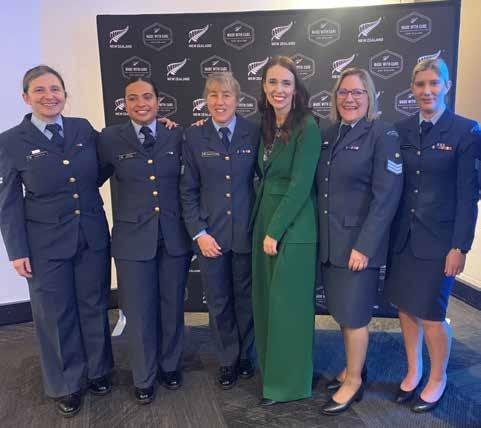
The aim was to identify challenges and discuss solutions to the issues affecting enlisted women in the technical trades.
The presentations included some thought-provoking topics and included Royal Australian Air Force (RAAF) leaders such as Warrant Officer-Air Force Ralph Clifton, Air Vice-Marshal Wendy Blyth (Head of Air Force Capability), and Air Commodore Leanne Lee (Director of General Aerospace Combat Systems).
RNZAF Flight Sergeant Daff Pringle gave a rousing presentation on Op Tangata Kanorau (Op TK) and the School to Skies programme, which were extremely well received.
One observation made was the absence of female technicians in the higher non-commissioned ranks in the RAAF. The RAAF (made up of about 14,000 personnel) currently has one female Flight Sergeant each in both the aircraft and avionics trades and no Warrant Officers. This gives special meaning to the quote “You can’t be what you can’t see.”
Our Air Force in comparison is well represented having several female Flight Sergeants and Warrant Officers across all our technical trades!
Along with attending the conference, Air Force attendees were invited by the New Zealand High Commission to Mana Wāhine, celebrating the spirit, leadership, and excellence of women.
The guest speakers for this event were Dame Jacinda Ardern, the Honourable Julie Bishop, actor Rena Owen and Olympic swimmer Bronte Owen. This was a fun and insightful evening to end what was a very worthy and rewarding conference.
A massive shout out to Sergeant Jenn Harmon who had attended the previous year’s By Techs for Techs conference while working at No. 11 Squadron on the P-8A Poseidons at RAAF Base Edinburgh and having the forethought to put forward the initiative for RNZAF representation at this year’s conference.
To the RNZAF Directorate of People and Culture lead by Wing Commander Jen Ross and supported by Squadron Leader Sarah Collins, thank you for picking this up with such gusto and support, Group Captain Susie Barns (Logistics Commander, Air) for supporting and funding our aviators’ attendance, and Air Adviser Canberra Wing Commander Becs Maynard for putting it all together.
| TECHNOLOGY
FLIGHT SERGEANT JO BEAVEN B Y
LEFT TO RIGHT
18 | AIR FORCE NEWS #262
CPL Janice Bond, CPL Germaine Purea-Colvin, F/S Daff Pringle, former Prime Minister Dame Jacinda Ardern, F/S Jo Beaven, SGT Jenn Harmon
NZDF cyber capability tested in US military exercise
New Zealand Defence Force personnel have taken part in a United States-led exercise to develop military cyber capability to defend against today’s online threats.
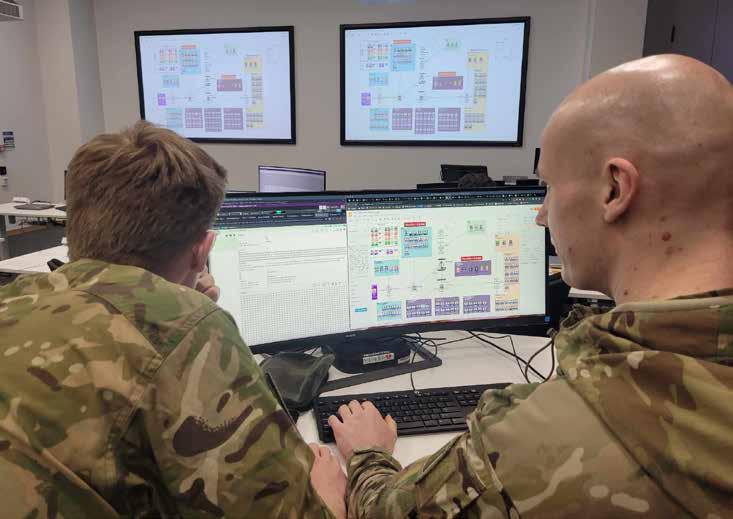
Exercise Cyber Flag is a biannual United States Cyber Command exercise designed to build capability to conduct defensive cyber operations outside of standard IT networks. It also provides an opportunity to develop, assess and validate skills in a multinational environment.
The Defence Force contributed to the exercise alongside other New Zealand government agencies both in the US state of Virginia, and remotely. There were two Cyber Protection teams made up of Regular Force, Reserve Force, and civilian personnel.
One team was made up of operators from the Air Force, the Royal New Zealand Navy, and Defence Force civilians from the Defence Cyber Service Centre. The second team consisted of NZ Army personnel and Special Forces. There were also personnel acting as opposing forces simulating attacks and exploitation.
Jared Licht, Defence Force Chief Information Security Officer, said Cyber Flag was critical in continuing the development of the Defence Force’s cyber capability.
“This multinational tactical exercise is designed to enhance the capabilities needed to conduct defensive cyber operations. It provided an opportunity to improve interoperability by giving us a valuable opportunity to collaborate with partners, and then test their skills against opposing cyber forces.”
Lieutenant Riordan Morrell said it was a beneficial training experience.
“The team did extremely well, keeping critical protected systems up and running in the face of an advanced threat.”
Success in the exercise was serious testament to the qualities and training of non-commissioned officers and junior personnel, he said.
TECHNOLOGY |
AIR FORCE NEWS #262 | 19
Skilful WorldSkills
Engineers from an array of industries gathered at Base Woodbourne recently to compete in the WorldSkills NZ national selection competition. Among the contenders were Leading Aircraftman Sam Munday and Leading Aircraftman Teone Wilkinson.
The competitors were all young engineers aged under 25 who were either training to become engineers, or already employed as engineers in the aviation industry.
The two Air Force No. 6 Squadron aircraft technicians said they were in familiar territory performing the tasks for the competition as they were similar to their work they did every day at Base Auckland – but the time constraints to complete them added pressure.
“For the two of us it was a confidence booster because the Air Force is filled with so many high performers across every trade,” Leading Aircraftman (LAC) Wilkinson said.
“In the competition you have to do a job and you’ve got no time to do it – whereas we don’t have those tight time pressures at work. Once you know you can handle a job to a high standard in a short amount of time, you carry that confidence and bring it back to your unit with you.”
The competitors carried out three assignments during the event: a 1.5 hour inspection of a Mitsubishi MU-2 aircraft to ensure it was safe and fit for flight with 13 faults hidden for them to find; a sheet metal fabrication task that replicated the skills needed to make and install a repair to an aircraft’s structure; and changing a fuel filter on a helicopter turbine engine in 1.5 hours.

“It was pretty comfortable because every day we do daily inspections. It was very familiar territory to look around and work out what was wrong with the picture, document it and let someone know. I don’t think either of us found it too challenging,” LAC Wilkinson said.
During all the tasks competitors must display accuracy, attention to detail, interpret the maintenance manuals, maintain quality standards, observe safety and legislative requirements, maintain situational awareness, and accurately record the maintenance carried out plus any defects found.
| TECHNOLOGY
REBECCA QUILLIAM B Y
EDITOR
20 | AIR FORCE NEWS #262
LAC Munday said while the fuel filter change was a common procedure for him, the task was no walk in the park.
“The time pressure kept me on my toes –it sneaks up on you quite quickly. But with our training it wasn’t something unfamiliar, it helped us quite a lot.
“It was also good to hear what the training involved was like for the other competitors who came from different industries,” he said.
LAC Wilkinson made it through to the next level and will compete in the national competition in November, at the Air Force Museum of New Zealand in Christchurch. Both he and LAC Munday recommended Air Force personnel take part in future WorldSkills events.

“It was a really good networking opportunity. It was good to hear about different cultures at other workplaces. There are a lot of people leaving Defence to work at other industries, so I was really surprised to hear from the
Air New Zealand guys they were envious of some of the things we did in the Air Force,” LAC Wilkinson said. The engineers, keeping an eagle eye on the competitors and judging their skills, also came from a number of organisations including Air New Zealand, ServiceIQ/Te Pukenga, the Air Force, and Airbus NZ.
WorldSkills is an international not-forprofit organisation that fosters vocational education and training. Eighty-five countries are part of WorldSkills and over 63 different skills are contested. The competitions are held over a two-year cycle with domestic competitions in one year leading up to the international competition the following year.
TECHNOLOGY |
“For the two of us it was a confidence booster because the Air Force is filled with so many high performers across every trade.”
– Leading Aircraftman Teone Wilkinson
LEFT
LAC Sam Munday carrying out a component change on a Seasprite engine
AIR FORCE NEWS #262 | 21
RIGHT LAC Teone Wilkinson riveting on the aircraft structure test
On the road with a Lockheed P-3K2 Orion
It is not every day you see a Lockheed P-3K2 Orion making its way gently through the Canterbury High Country on the back of a truck. Air Force News went along for the ride.
Eat your heart out Clarke Gayford! The Moving Houses host is nowhere in sight as our special Air Force Museum of New Zealand convoy carefully makes its way from Base Woodbourne to Christchurch with NZ4203 aboard.
It’s a shame Clarke couldn’t make it because the NZ4203 convoy attracted plenty of curiosity and photo opportunities wherever it went.
The convoy departed Woodbourne just before 3am and arrived at its first stop in Murchison before dawn to give the drivers a break.
Up with the larks in Murchison is Leilani Krans-Tunnage, who arrived early to get a look at the convoy’s precious cargo. Leilani served in the Air Force for five years and was an air ordnanceman aboard NZ4203 on many missions.

She was the first female in her trade and loved her time aboard the aircraft.
“It’s a beautiful machine. I had a lot of amazing adventures on Orions and NZ4203 is all through my logbook,” she said.
“I have to say I was a bit emotional at first to see her in pieces, but I’ll be coming to have a look once she is all back together.” Another early visitor to the museum is likely to be Group Captain (rtd) Rick Bulger who was co-pilot on NZ4203’s delivery flight from the United States in 1966. He flew Orions for 21 years, which he says “ruined” him for flying anything else. “They are a beautiful aircraft in every way – powerful, responsive and a joy to fly. I flew so many hours on NZ4203 I regarded her as my aircraft. Although I was thinking the other day, I flew for 21 years, which is a lot, but still less than half of her eventual lifespan of 54 years! That is an incredible amount of service.
| OUR HERITAGE
AIR FORCE MUSEUM OF NEW ZEALAND DAVID KING, COMMS MANAGER B Y
22 | AIR FORCE NEWS #262
“I wish her a happy retirement. I’m delighted the museum got that airframe.”
Air Force Museum of New Zealand Collections Manager Darren Hammond thanked the teams at Woodbourne and the heavy haulage specialists who took extra care to get the precious cargo to Christchurch safely.

The most efficient way to get NZ4203 to Christchurch was to dismantle the aircraft using a specialist team at Woodbourne and transport it by road for reassembly at the museum.

The Woodbourne-based team has been caring for the Orion fleet for decades and had all the know-how – as well as the tooling – required.
NZ4203 will be displayed as if the aircraft had recently landed, and the four mighty T-56 engines had just been switched off. “It will have been demilitarised and made safe but to all intents and purposes it is a working aircraft with everything in great condition,’’ Mr Hammond says.
“We can’t thank everyone at Woodbourne enough for all the care that has gone into the work. The condition is a testament to them and to all the crews who cared for NZ4203 over its 54-year working life.”
The wings, fuselage, engines and props are being stored in the museum’s Number 3 hangar before being reassembled next year.
Air Force Museum Director Brett Marshall says NZ4203 is the largest aircraft in the museum’s collection, and it is anticipated it will be joined by a C-130H, which the museum hopes to get once the Hercules fleet is retired.
“These two aircraft are the Defence Force’s longest serving pieces of military equipment bar none and the focus now turns to the building of an exhibition hall large enough to display them in so their stories, and those of all our service personnel who have interacted with them over the past five plus decades, can be told.”
The build will be a large undertaking but with the support of the Defence Force, our current and ex-service personnel, and the wider public of New Zealand, it is something the Museum is now strongly leaning into, Mr Marshall says.
“We’re really excited to have been gifted NZ4203 and to have the opportunity now to build an exhibition space to tell the Orion and Hercules’ incredible stories to the more than 150,000 visitors who come to our museum each year. We’re very much up to the challenge.”
OUR HERITAGE |
LEFT
Leilani Krans-Tunnage with the convoy in Murchison
RIGHT
AIR FORCE NEWS #262 | 23
NZ4203 being loaded onto its trailer at RNZAF Base Woodbourne
Sound of the Orion
Four sailors on board the yacht the SV Jungle, Geoff Marsland, Roger Young, Peter McLean (captain) and his son Sam McLean found themselves shipwrecked on a reef in June 2017 in the dead of night with waves crashing against the stricken vessel. They thought they wouldn’t make it through to morning.
Sitting in Mr Marsland’s Havana Coffee Works office in Wellington, along with Mr Young, there is evidence dotted around of the sailors’ rescue after hitting Tuvana-I-Ra atoll, about 425km south east of the Fijian capital of Suva.

The Epirb (Emergency Position Indicating Radio Beacon) that sent their coordinates to the New Zealand Rescue Coordination Centre is hanging on a wall alongside a framed photo of the P-3K2 Orion, signed by the aircrew, who spotted the four companions.
The group had been travelling around the South Pacific, heading for Tonga, when the boat’s backstay broke, 300km short of their destination, affecting the vessel’s ability to sail.
The strong currents were pushing them away from Tonga, so the group changed course and headed towards Fiji.
“We knew we were heading towards an area where our charts were inaccurate up to a couple of miles and there were random reefs around. And when the night came there was no moon at all,”
Mr Marsland said.
“About 3am when I was coming off watch it was really dark, but something didn’t feel right – it was uncanny. I woke up the skipper to change watches and told him something wasn’t right.”
The captain checked the charts and started the generator, but by that stage it was too late.
“I thought I could hear waves crashing on a reef. So I leant across to listen. And then I looked up and could see the reef – the light from the mast picked it up and I just shouted, ‘We’re going to hit a reef!’ Mr Marsland said.
“We just went straight up onto the reef and as we did the rig came down and the boat turned 180° so we were facing back towards the sea. Then a wave came and dumped into the boat.”
| OUR HERITAGE
EDITOR REBECCA QUILLIAM B Y
“Just as we got to the beach I remember hearing the Orion and I looked up and started bawling my eyes out.”
– Geoff Marsland
LEFT (L–R) Geoff Marsland holding the Epirb that led the Orion to the shipwreck location, Roger Young
RIGHT
24 | AIR FORCE NEWS #262
Photos taken of the stricken yacht and crew from the Orion as it passed overhead
Mr Young said he rushed up the companionway when he was woken by Mr Marsland’s warning.
“I’ll never forget the sound of the keel on the reef – a real scraping sound. There was a big swell and a high tide which pushed us up and onto the reef. I just remember that wall of water knocking me off my feet and throwing me back down the companionway.”
Disoriented and with the water taking out the vessel’s communications, the men kept repeating the boat’s coordinates so they wouldn’t forget them.

“The whole navigation area was underwater and then we lost power to our satellite phones. We didn’t have any communication apart from the Epirb. Straight away we turned the Epirb on and put on our wet weather gear,” Mr Marsland said.
“I remember looking at Geoff and we were both thinking this could be it, we’re not going to see our kids again. It was dark, the boat was full of water and it’s crashing on the reef,” Mr Young said.
However, luck was on their side. The boat stayed intact and when it started to get light they could see an island not far from the reef, which was inhabited by four Fijians who lived there for four months of the year collecting sea slugs for the Chinese market.
“I started walking across the reef towards the island and shouting: ‘Bula, bula’, and then they smiled and came over – they were wary of us at first. The chief told us he could get us back to the island and so we grabbed our grab bags and passports,” Mr Marsland said.
“I had a few bottles of Cuban rum so grabbed those and some carrots, garlic and oranges and doggy paddled across to the island holding our gear above our heads.”
Just as the group arrived on the island the welcome sound of an Orion was heard overhead. Aircrew called their VHF radio, which was almost flat, and asked if there were any injuries, which there weren’t apart from some scratches. The aircrew then dropped a new VHF radio and water to the stranded boaties and told them a rescue would be organised and families would be told they were safe.
The Orion’s crew also dropped a bag filled with chocolate and chips. “It was such a warm feeling knowing everything was going to be alright.”
The family on the island then chopped down some coconuts, which were filled with rum, and killed a couple of chickens to be cooked with the vegetables that had been brought from the boat. That night the family let the men sleep in their sleeping bags to save them from the island’s rats who would be attracted to the cuts they had suffered. The next day they returned to the boat and salvaged everything not ruined by the water and gifted the boat to the family.
“Cyclone Gita came through a week later and pushed the boat straight up onto the beach. The family’s little hut they had been living in was wiped out, but they ended up with the boat to live in,” Mr Young said.
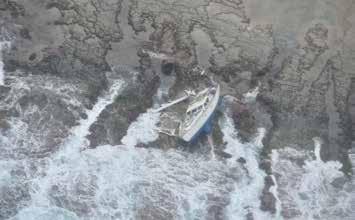
“We said goodbye to them, which was quite emotional and then the Fijian Navy turned up and took us to Fiji,” Mr Marsland said.
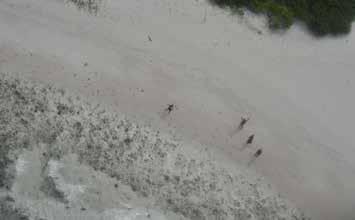
OUR HERITAGE |
AIR FORCE NEWS #262 | 25
| HEALTH FOR MORE INFORMATION Contact your NZDF health provider via local Defence Health Centre or via 0800 268 437. www.accsportsmart.co.nz/concussion/ www.acc.co.nz/preventing-injury/traumatic-brain-injury-tbi/ 26 | AIR FORCE NEWS #262
Looking after your brain during military service
Why is brain health important?
Brain health impacts many areas of your physical and mental wellness. Your brain function is finely tuned to perform optimally, and sometimes even minor disruptions through injury or illness will have a profound effect on your quality of life.
Injuries or impacts to your brain can be challenging to recover from and will affect many areas of your life, and that of your whānau. Tasks important to being an effective service member, such as decision making, problem solving, impulse control, attention span and reaction time, can be negatively impacted by poor brain health. Preventing injury to your brain and adopting habits that protect the health of your brain is a valuable approach, especially for any service people.
What are hazards to brain health?
Unforeseen accidents can result in direct brain injuries. Activities such as contact sports can also injure the brain, either through repeated mild blows that you seemingly recover from, or through significant collision and head injuries.
The most frequent causes are motor vehicle accidents, then falls and contact sports. In the Aotearoa New Zealand general population motor vehicle accidents, falls and assaults are common causes. Twenty percent of Traumatic Brain Injury in Aotearoa is from sportrelated activity.
Some military weapons systems have been shown to generate sufficient force that can generate a hazard to your brain in the same way a minor direct blow to the head might.
Weapons that concentrate a large amount of force, either through pressure (such as that given off by explosives) or from repeated movement effect (such as recoil from high calibre weapons) can effectively disrupt your brain similar to a minor blow, shake or jolt. In the training environment, these effects happen at a low level. A single exposure to a pressure or recoil effect is not likely to effect your brain. When this hazard is repeated too many times in a short time frame, without time to recover, the effect could be hazardous to your brain health.
Research is still ongoing to learn more about these military hazards. Weapons systems in the Defence Force such as explosives and high calibre weapons have safety guidelines around them to significantly reduce cumulative exposures and to monitor effects on personnel. This ensures that the Defence Force can prevent hazardous exposures before they effect the health of operators.
Some substances can also be toxic to your brain, the most common one being alcohol. Drugs can also damage and contribute to cumulative poor brain health. What symptoms should I be concerned about?
Memory, balance, concentration, headaches, hearing problems, sensitivity to light, fatigue, and irritability are all common symptoms of poor brain health. However, many of these symptoms overlap with other more common causes. Similar symptoms occur in mood disorders (such as depression and anxiety), post viral infection complications (such as long Covid), metabolic problems, obstructive sleep apnoea, and medication side effects.
It is critical that if you identify troublesome symptoms that you seek health support to assist in finding the cause and assisting recovery for the issue.
What can you do to protect yourself?
Try to prevent injuries or insults to your head and brain health. Consider that any brain injury, even a mild concussion, can have an ongoing impact, especially if you get subsequent injuries over your lifetime. Seek health support after every mild head injury. Pay attention to stand down times for contact sports and get clearance from a health professional if you want to return to play and to full military activity after a head injury.
Minimise exposure to toxins that can effect your brain health such as alcohol and drugs.
Make sure you are familiar with the hazards of any weapons systems or military activities you are exposed to. It is recommended to not expose yourself to brain health risk from several sources at the same time i.e. if you are doing training with a weapons system that has hazards to your brain, take a break from contact sports and alcohol during your training period.
What do you do if you are concerned about symptoms?
If you have symptoms that are concerning you or your whānau, it is important that you seek a health professional’s opinion. There are a range of conditions that can cause symptoms similar to brain injury and it would be important to identify exactly what is going on with your health so that the right treatment can be initiated.
If you are an instructor or leader for an activity or training serial, make sure you understand the hazards involved and have an effective risk management plan to mitigate those hazards. Encourage your people to speak up with concerns and involve health providers early to assess anyone with concerning symptoms.
HEALTH |
AIR FORCE NEWS #262 | 27
COLONEL CHARMAINE TATE B Y
Invictus team uplifted by competition in Düsseldorf
The 2023 Games, held in Düsseldorf, ended last month after eight days of competition. The closing ceremony was attended by Games’ patrons, Prince Harry and Meghan Markle, the Duke and Duchess of Sussex.
The Games are the only international adaptive sporting event for wounded, injured and ill active duty and veteran service members – using the power of sport to inspire recovery and support rehabilitation.
Reaching the podium winning a silver medal for discus and indoor rowing was Royal New Zealand Air Force Flight Sergeant Stacey Adam.
This year’s Games attracted about 550 competitors from more than 20 nations competing in 10 sporting disciplines.
The 21-member New Zealand team, swinging poi at the closing ceremony, was led by flag-bearer, Able Communication Warfare Specialist (AWCS) Paulette Doctor, a double breast cancer survivor, who won the last of New Zealand’s five medals – a bronze in table tennis.

“Invictus means so very much to me, it’s helped me out of dark times and continues to uplift me when I’m low,” AWCS Doctor said.
“It fills my cup more than I think I deserve and for that I am so grateful and honoured.”
Team manager, Commander Julie Fitzell, said the Games had been life-changing for many.
“I have witnessed confidence, joy and strength grow within the team,” she said.
“What shone through at the Games and made our Kiwi team so special was our united strength – bonds created that will live well past the Games. They had each other’s backs and trusted each would catch the other if they stumbled.
“I’m immensely proud of their ability to push through the challenges they each have. They turned up and just smashed it, with many achieving personal bests beyond what they first thought capable.”
| INVICTUS
28 | AIR FORCE NEWS #262
The New Zealand Invictus Games team says the journey to compete against other military veterans has been life-changing for some as they “smashed it” at this year’s tournament in Germany.
Head of Mission, Chief of Army, Major General John Boswell, said the Games were about providing people with opportunity.
He said the New Zealand team members had set their own objectives and goals, and they are all pursuing them in their own way.
“It doesn’t matter if it’s just making it round the track or winning a gold, it’s about doing what they can for themselves to the best of their ability and just enjoying the opportunity.”
More than 140,000 people attended the events, which were also livestreamed and broadcast worldwide.
In his games-closing speech, Prince Harry said they had all witnessed the true impact sport had on competitors’ recovery and their post-traumatic growth. “You have opened people’s hearts through your vulnerability, resilience and through your sheer abilities. You have shown us that joy can emerge from struggle. And for that, we are eternally grateful.”
German Federal President, Frank-Walter Steinmeier said the competitors’ strength to keep going every single day had brought them together in Düsseldorf.
“For eight days you have been together with people who understand precisely where you’re coming from when you tell your story. And that is exactly the reason for these Games.”
The next Invictus Games will be held in Canada in 2025.
NEW ZEALAND’S MEDALS AT THE 2023 INVICTUS GAMES:

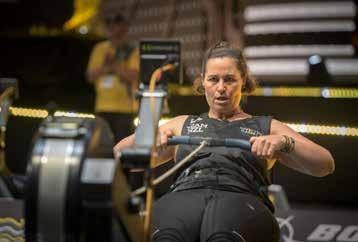
GOLD
100m sprint
Royal New Zealand Navy (RNZN)
Leading Physical Training Instructor
Jack Church
SILVER
Discus and indoor rowing
Royal New Zealand Air Force
Flight Sergeant Stacey Adam
MAIN
Invictus Games opening ceremony
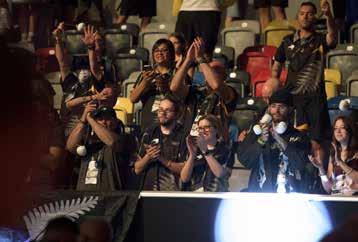
TOP LEFT
New Zealand supporters cheering on the NZDF team
TOP RIGHT
F/S Stacey Adam competing in the indoor rowing event
BOTTOM LEFT
F/S Stacey Adam with a podium finish
BOTTOM RIGHT
Former Air Force personnel Mike Cotton preparing for his bike race

Powerlifting
NZ Army Staff Sergeant
Melissa Hansen
BRONZE Table tennis
RNZN Able Communication Warfare Specialist Paulette Doctor
INVICTUS |
AIR FORCE NEWS #262 | 29
Hooked on hockey
The Air Force recently hosted the 2023 Interservice Hockey Tournament featuring men’s and women’s teams from the three services and the NZ Police, totalling 141 personnel, at the National Hockey Centre at North Harbour.
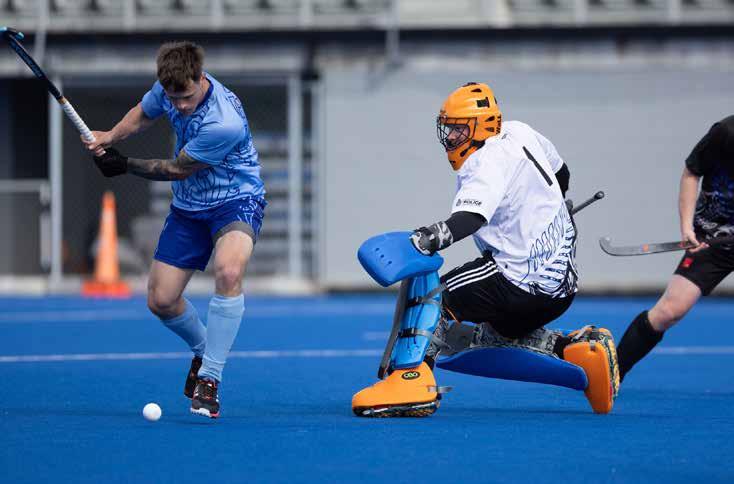
Day one in the men’s competition saw Navy beat Police 3-0 while Army and Air were locked at 2-2 at full time with Army winning the shootout 3-2. In the women’s competition Police beat Navy 3-0, while Army beat Air 1-0.
Day two in the men’s competition saw Navy beat Air 5-0 while Police and Army drew 1-1 with Army winning the shootout 3-2. In the women’s competition Navy women beat Air women 2-0 while the Police beat Army 3-1.
Day three in the men’s competition saw Air beat Police 3-1 while Navy beat Army 5-3. In the women’s competition Police beat Air 2-0 while Navy beat Army 2-0.
During the tournament closing function Warrant Officer (Rtd) Brian (BK) Read,
Patron of RNZAF Hockey presented Lieutenant Commander (LTCDR) Jan Peterson, captain of the Navy men’s team with the Read Trophy as winners of the men’s interservice tournament.
Base Auckland Base Commander Group Captain (GPCAPT) Mike Cannon then presented Petty Officer Electronic Technician Tamara Dudley, captain of the Navy women’s team with the Sam Kereama Memorial Trophy as winners of the women’s inter-service tournament. NZ Police were presented with the Ces Cameron Cup – Spirit of Hockey Award.
GPCAPT Cannon also presented LTCDR Peterson with the Army Hockey Association Trophy as the men’s Most Valuable Player, Corporal Jade Forman with the RNZAF Hockey Association Trophy as the women’s Most Valuable
| SPORT
WORDS | SQUADRON LEADER STEVE HANCOCK PHOTOS | GARY FRASER, PLANET HOCKEY
30 | AIR FORCE NEWS #262
Player and Mr Angus Griffin (RNZAF) with the Navy Hockey Club Trophy as the most promising player.
The base commander also presented LTCDR Peterson, captain of the Navy men’s team the Pope Trophy as winners of the men’s combined services competition and the captain of the NZ Police women’s team with the Sommer Trophy as winners of the women’s combined services competition.
The RNZAF Hockey Association wishes to thank the BCDR AK for hosting the tournament, the organising committee, ESS and the North Harbour Hockey Association and umpires who all contributed to a successful tournament.


THE FOLLOWING DEFENCE FORCE MEN’S AND WOMEN’S TEAMS WERE NAMED:
Men:
FLTLT Jake Bullott (Coach), SQNLDR Dave Timbs (Trainer), CPL Daniel Boustridge, LAC Byron Buys, FLTLT Jamie Besley, Mr Angus Griffin (new cap) (all RNZAF), MID Alex Eichelbaum (new cap), O James Harris (new cap), A Myles Vos, LTCDR Jan Peterson, A Chavez Rahurahu, O Harrison Kemp (new cap), LTCDR Ambrose O’Halloran (all RNZN), SGT Craig Culver (Manager),SIG Robert Belchamber, SPR Amiri Downs-Williams (new cap), LCPL George Littlejohn, PTE Dylan Muggleston, LCPL Brad Collins (new cap), LCPL Tux Tukapau and LCPL Kent Horsley (all NZA).
Women: PO Tamara Dudley (Coach), PO Jeremy Rees (Asst Coach), A Sienna-Marie King (new cap), PO Alex Carter, PO Samantha-Joan Scothern, ENS Hannah Larsen, A Paige Harvey (new cap), A Petra Dye-Hutchinson, A Nadia Mwila, L Keisha Coutts (all RNZN), W/O Ann Clarkson (Manager), AC Kristen Smith, CPL Nicola Murray, CPL Jade Forman, LAC Alice Roughan (new cap) (all RNZAF), CAPT Sandra Mitchell, LT Toyah Churton (new cap), 2LT Elese Russell, WO2 Diane Kareko, LCPL Rosemary Reed, LCPL Ariana Blackwood (all NZA).
SPORT |
AIR FORCE NEWS #262 | 31




















F O R D E T A I L S A N D T O R E G I S T E R V I S I T A E R O S P A C E N Z . C O M aerospacenz.com @aerospacenz 32 | AIR FORCE NEWS #262
VOLUNTARY EDUCATION STUDY
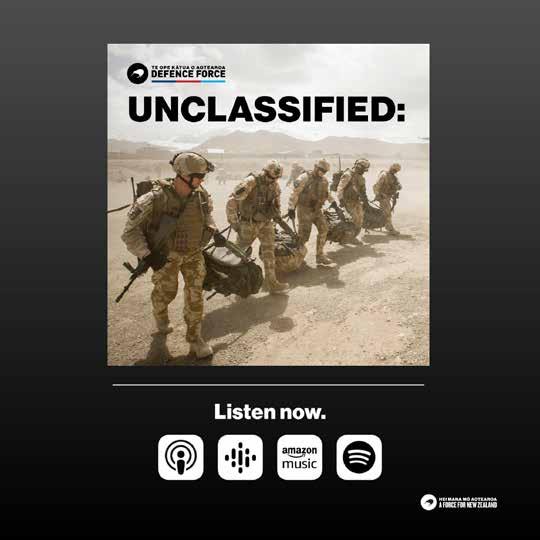
Semester Three/Summer School, 2023 applications are being
You may submit your request for funding within 90 days of your study start date. Apply online (ILP) at Training & Education, New Zealand Defence College (NZDC), Learning Toolkit VESA Application (e-form).
Applicants should be aware of their responsibilities prior to making an application, IAW Defence Manual of Learning (DMoL), Part C, Chapter 2: Voluntary Education Study Assistance. This chapter of the DMoL and its subordinate process manual, replaces SADFO 3/2016.

Other than a new policy to govern eligibility and study criteria, as mentioned
Increased postgraduate and undergraduate funding limits

Introduced the option to study micro-credentials at Level 4 or higher, that sit on the New Zealand Qualifications Framework
Prior to starting the application process, applicants are to: Confirm the level of study is right for them with Defence Learning, NZDC

Provide supporting paperwork including study documentation from the official learning provider website (ready to attach to your e-form application)
Contact your local Adult Learning Tutor, Defence Learning, who can assist you with your application. If you have any queries, please email our Tertiary Services & Support Advisor at nzdcdlearnvesa@nzdf.mil.nz
SUPPORT ORGANISATIONS As a past or present aviator of the Royal New Zealand Air Force there are a number of organisations designed to support you in a variety of ways.
include financially, rehabilitation services, workplace support, support for you and your family in case of illness, injury or death, and keeping in
with
These
touch
old colleagues.
organisations
0800 483 8372 or +64 4 495 2070 www.veteransaffairs.mil.nz www.missingwingmantrust.org.nz Royal New Zealand Air Force Association Inc. rnzafanatsec@gmail.com PO Box 164, Kirwee 7543
Please look into these
for support you might need:
AIR FORCE NEWS #262 | 33
I took this image during an exercise with No. 3 Squadron and the NZ Police Special Tactics Group. It was a No. 3 Squadron readiness activity designed to train helicopter crews in counter terrorism operations. This photo was taken after all of the Police personnel had just finished fast roping from the NH90 down to the ground and returning to the helicopter. I don’t usually work with black and white when I take photographs, although with this task I thought I would try something a bit different, and I think it made quite a cool effect for this image.
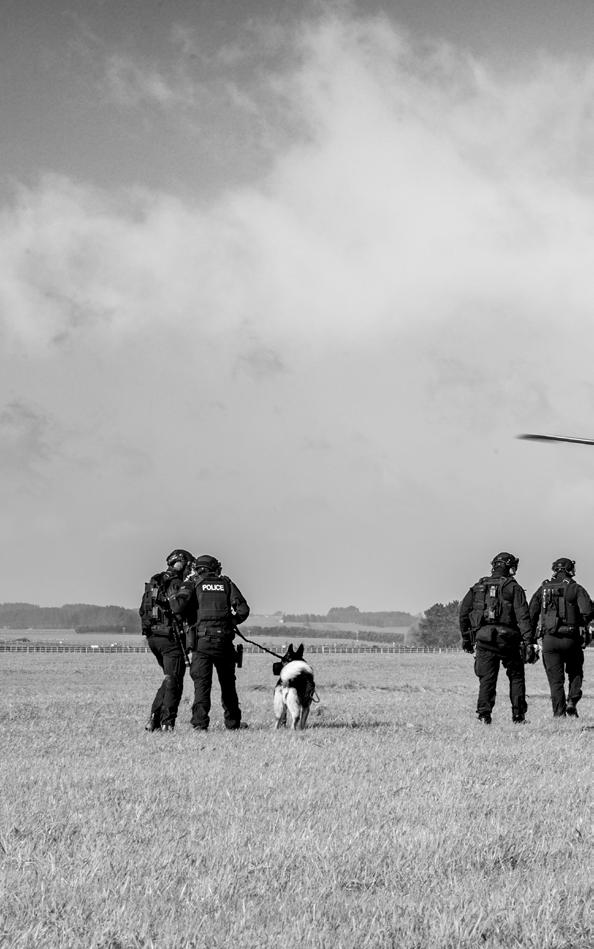
| PHOTO OF THE MONTH
CORPORAL MADDY BUTCHER B Y 34 | AIR FORCE NEWS #262

AIR FORCE NEWS #262 | 35
The A I R F ORC E In Concert

Sunday 12 November 2:30 pm
Tickets available from Ticketmaster. Booking fees apply.
 Michael Fowler Centre, Wellington
Michael Fowler Centre, Wellington












 EDITOR REBECCA QUILLIAM B Y
EDITOR REBECCA QUILLIAM B Y

















































